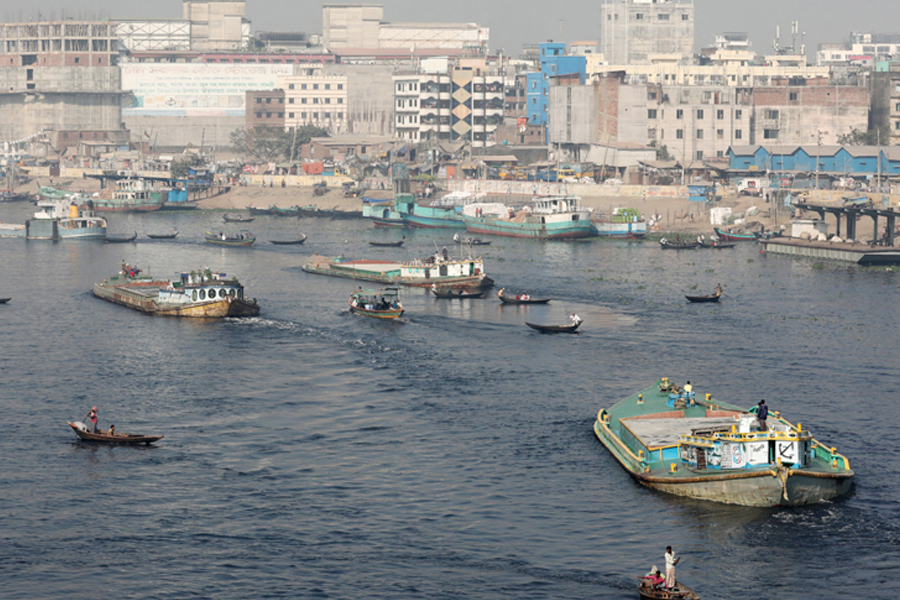
Published :
Updated :

While rivers across Bangladesh face grave vulnerabilities-encroachment, pollution, siltation, and declining navigability-the situation is particularly dire for the rivers surrounding Dhaka. A couple of them are practically lifeless, having lost their channels altogether. Despite repeated calls for their preservation and the adoption of a 20-year master plan to protect them, meaningful progress remains elusive.
Rivers in Bangladesh are among the most neglected victims of urban expansion and unregulated human activity. Those flowing close to major townships, business centres, and urban habitats have long been subjected to relentless abuse. This is a story as old as the country's development narrative: lawlessness and anarchy, fuelled by greed and, above all, the inability or unwillingness of authorities to rein in the prevailing lawlessness.
Occasional eviction drives led by the Bangladesh Inland Water Transport Authority (BIWTA) have attempted to recover encroached lands. Yet these sporadic efforts have rarely convinced citizens that the government is fully committed to the task. A lingering cynicism prevails regarding the state's firmness in confronting vested interests and restoring the rivers to their earlier states.
Past eviction drives were largely disorganised and ineffective. However, the BIWTA's 2019 initiative marked a turning point. It was better coordinated, appeared politically backed, and seemed to reflect genuine intent. On the banks of major rivers around Dhaka-including the Buriganga, Turag, and Shitalakhya-multistoried structures, warehouses, and factories were demolished, and large stretches of encroached land were reclaimed.
For a moment, public optimism surged. While some influential quarters managed to evade eviction through political connections or favourable court orders, the overall momentum of the campaign hinted that even these holdouts would eventually face action. Yet, despite its initial success, the drive faltered prematurely. Funding constraints were cited as a key obstacle, raising questions about the government's prioritisation of such a critical issue.
One crucial follow-up measure was the demarcation of riverbanks to prevent renewed encroachment. Work began under a project that included installing boundary pillars, constructing protective embankments, building walkways, and undertaking other development initiatives along the Buriganga, Turag, Balu, and Shitalakhya rivers.
Progress, however, was again slowed by the Covid-19 pandemic. Time and cost overruns forced the BIWTA to seek additional funds, revising the project to include new components such as the construction of 35 kilometres of drains along walkways. Plans also included the installation of 3,850 boundary pillars, 17.75 kilometres of walkways, dredging of 18.21 million cubic metres of earth, and the development of four river stations and 14 jetties for transport services. Despite these ambitious goals, the project's current status remains uncertain, underscoring the chronic delays and a lack of transparency that have long plagued river conservation efforts.
While eviction drives and development works have received some attention, pollution-the most insidious threat-remains largely unaddressed. An estimated Tk 270 billion spent over the past 27 years to improve the Buriganga's condition has yielded little. Experts argue that ill-conceived projects and piecemeal interventions have failed to address the root causes.
According to experts, Dhaka's rivers are mainly polluted by the upstream rivers, and there are about 1,200 pollution points, many originating upstream. Industrial waste, untreated sewage, and rampant dumping continue. The crisis worsened after the 1988 floods when the authorities cut Dhaka off from nearby rivers and wetlands, a move that not only dried up natural water flows but also contributed to chronic waterlogging in the city. Without a comprehensive strategy to tackle pollution at its source, restoration remains a distant dream.
Equally pressing is the issue of navigability. Many river channels, once vital for transport and trade, have been obliterated by illegal earth filling. The loss of navigability not only disrupts commerce but also cripples urban transport alternatives. For instance, the much-publicised water bus service in Dhaka failed primarily because of shallow riverbeds during the lean season. While there were management flaws as well, adequate navigability could have salvaged the initiative.
Restoring these channels is not just a matter of convenience; it is a matter of survival for the city. Historically, rivers have been lifelines for urban development, offering natural transport routes, facilitating trade, and providing fresh water for households, industries and agriculture. They also contribute to the cultural and aesthetic fabric of cities. To allow them to wither away is to undermine Dhaka's very foundations.
In 2021, a 20-year master plan was drafted to comprehensively address pollution, illegal occupation and navigability. It promised a holistic approach, combining eviction, restoration, infrastructure development and pollution control. Yet, like many well-meaning plans before it, implementation has stalled.
At this critical juncture, it is imperative for the authorities to translate plans into action. Dhaka cannot afford further procrastination. With the current interim government's apolitical nature, there exists a rare window of opportunity to enforce measures without the usual political interference. Transparent implementation of the master plan, coupled with consistent funding and accountability, could revive Dhaka's rivers and restore their role as engines of urban life. The need now is for sustained effort, political will, and public accountability. Only then can these rivers-once symbols of life, trade and culture-be revived to serve the capital once again.
wasiahmed.bd@gmail.com


 For all latest news, follow The Financial Express Google News channel.
For all latest news, follow The Financial Express Google News channel.